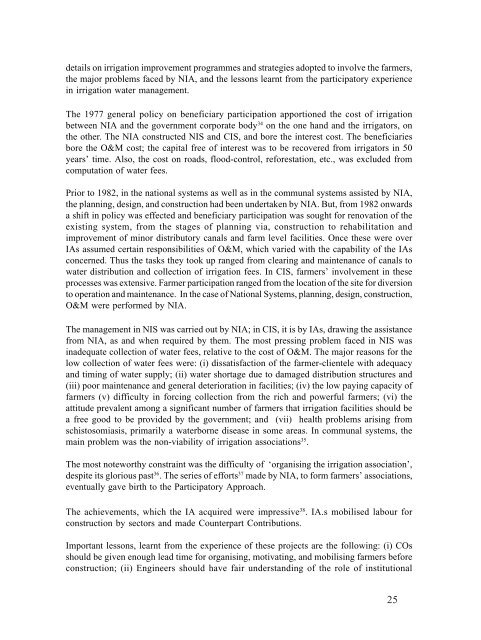Beneficiary Participation in Irrigation Water Management: The Kerala
Beneficiary Participation in Irrigation Water Management: The Kerala
Beneficiary Participation in Irrigation Water Management: The Kerala
You also want an ePaper? Increase the reach of your titles
YUMPU automatically turns print PDFs into web optimized ePapers that Google loves.
details on irrigation improvement programmes and strategies adopted to <strong>in</strong>volve the farmers,<br />
the major problems faced by NIA, and the lessons learnt from the participatory experience<br />
<strong>in</strong> irrigation water management.<br />
<strong>The</strong> 1977 general policy on beneficiary participation apportioned the cost of irrigation<br />
between NIA and the government corporate body 34 on the one hand and the irrigators, on<br />
the other. <strong>The</strong> NIA constructed NIS and CIS, and bore the <strong>in</strong>terest cost. <strong>The</strong> beneficiaries<br />
bore the O&M cost; the capital free of <strong>in</strong>terest was to be recovered from irrigators <strong>in</strong> 50<br />
years’ time. Also, the cost on roads, flood-control, reforestation, etc., was excluded from<br />
computation of water fees.<br />
Prior to 1982, <strong>in</strong> the national systems as well as <strong>in</strong> the communal systems assisted by NIA,<br />
the plann<strong>in</strong>g, design, and construction had been undertaken by NIA. But, from 1982 onwards<br />
a shift <strong>in</strong> policy was effected and beneficiary participation was sought for renovation of the<br />
exist<strong>in</strong>g system, from the stages of plann<strong>in</strong>g via, construction to rehabilitation and<br />
improvement of m<strong>in</strong>or distributory canals and farm level facilities. Once these were over<br />
IAs assumed certa<strong>in</strong> responsibilities of O&M, which varied with the capability of the IAs<br />
concerned. Thus the tasks they took up ranged from clear<strong>in</strong>g and ma<strong>in</strong>tenance of canals to<br />
water distribution and collection of irrigation fees. In CIS, farmers’ <strong>in</strong>volvement <strong>in</strong> these<br />
processes was extensive. Farmer participation ranged from the location of the site for diversion<br />
to operation and ma<strong>in</strong>tenance. In the case of National Systems, plann<strong>in</strong>g, design, construction,<br />
O&M were performed by NIA.<br />
<strong>The</strong> management <strong>in</strong> NIS was carried out by NIA; <strong>in</strong> CIS, it is by IAs, draw<strong>in</strong>g the assistance<br />
from NIA, as and when required by them. <strong>The</strong> most press<strong>in</strong>g problem faced <strong>in</strong> NIS was<br />
<strong>in</strong>adequate collection of water fees, relative to the cost of O&M. <strong>The</strong> major reasons for the<br />
low collection of water fees were: (i) dissatisfaction of the farmer-clientele with adequacy<br />
and tim<strong>in</strong>g of water supply; (ii) water shortage due to damaged distribution structures and<br />
(iii) poor ma<strong>in</strong>tenance and general deterioration <strong>in</strong> facilities; (iv) the low pay<strong>in</strong>g capacity of<br />
farmers (v) difficulty <strong>in</strong> forc<strong>in</strong>g collection from the rich and powerful farmers; (vi) the<br />
attitude prevalent among a significant number of farmers that irrigation facilities should be<br />
a free good to be provided by the government; and (vii) health problems aris<strong>in</strong>g from<br />
schistosomiasis, primarily a waterborne disease <strong>in</strong> some areas. In communal systems, the<br />
ma<strong>in</strong> problem was the non-viability of irrigation associations 35 .<br />
<strong>The</strong> most noteworthy constra<strong>in</strong>t was the difficulty of ‘organis<strong>in</strong>g the irrigation association’,<br />
despite its glorious past 36 . <strong>The</strong> series of efforts 37 made by NIA, to form farmers’ associations,<br />
eventually gave birth to the Participatory Approach.<br />
<strong>The</strong> achievements, which the IA acquired were impressive 38 . IA.s mobilised labour for<br />
construction by sectors and made Counterpart Contributions.<br />
Important lessons, learnt from the experience of these projects are the follow<strong>in</strong>g: (i) COs<br />
should be given enough lead time for organis<strong>in</strong>g, motivat<strong>in</strong>g, and mobilis<strong>in</strong>g farmers before<br />
construction; (ii) Eng<strong>in</strong>eers should have fair understand<strong>in</strong>g of the role of <strong>in</strong>stitutional<br />
25










